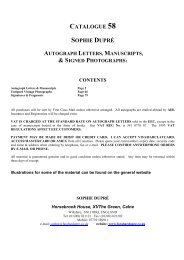CLIVE FARAHAR Catalogue 60
CLIVE FARAHAR Catalogue 60
CLIVE FARAHAR Catalogue 60
Create successful ePaper yourself
Turn your PDF publications into a flip-book with our unique Google optimized e-Paper software.
p. 113 11 signatures of ladies, including Maria Heugh, Dunlop’s future wife.<br />
p. 195 9 signatures, July 1862. Embassy from Mauritius to Madagascar for the coronation of Radama<br />
II. Including Major-General M.L. Johnstone, Governor of Mauritius, Vincent W. Ryan, the first Bishop<br />
of Mauritius, Mr Pakenham the British Consul in Madagascar, and Mr W.J. Caldwell in charge of the<br />
presents (see pp. 168-169, 174, 196, and especially p. 275 for an account of the Coronation).<br />
p. 167 26 signatures, possibly September 1862. Including “C.J. Meller [Surgeon] HMS Pioneer<br />
[Livingstone’s] Zambesi Expedition” and “Rassol [Madagascan] Officer 10th Honor”. On 5th<br />
September 1862 Dr Meller joined Gorgon at Tamatave for Mauritius (p. 170). Earlier, Dunlop notes<br />
that “Dr Meller, when he arrives, will be Vice-Consul” (p.274). See further below for Dr Livingstone.<br />
The pages are enlivened with cuttings from Punch and other magazines, including “the first telegraph<br />
station South Africa” (p. 21), from newspapers, including Dunlop’s marriage at Port Elizabeth (end<br />
cover), and verses about the famous chase by HMS Avon. Avon was sent to recall Sir Baldwin Wake<br />
Walker as he sailed for the Cape. After years of exhausting work at the Admiralty, Walker was not<br />
going to miss a command at sea, and Avon was no match for Narcissus (pp. 165-166).<br />
Chief among the Cape Squadron’s tasks are the interception of slave traders and maintaining<br />
communications in the South Indian Ocean. Dunlop was in Gorgon, October to November 1862,<br />
chasing slavers. In December 1862 Dunlop joins Ariel and is immediately sent off in command of the<br />
whaler and pinnace, routing out slavers along the coast of East Africa, followed by two cruises in<br />
Ariel’s tender Arielita, transferring to Rapid for the same purpose in April 1863. In conversing with a<br />
chief, he learns the raiders seize especially fishermen, whom they can sell in Madagascar. He has good<br />
success in burning the dhows while the raiders have fled ashore. He has constantly to determine<br />
whether a dhow is “legal” or fitted out for slaving. Live actions, successes, tragedies, the deployment<br />
of his men and individual bravery are vividly described. The maps (see Checklist) show the constant<br />
activity up and down the coast.<br />
In September 1861, Brisk sets off for Mauritius to convey the British mission to Madagascar to<br />
congratulate the new king Radama II on his accession. They find it has sailed in a hired ship, but<br />
follow to Tamatave. Dunlop’s account of the dinner with the local Governor is the first of many acute<br />
sketches of character and manners in the island (see pp. 104, 275).<br />
Next year, beginning on 12th June 1862, Gorgon has a similar role for Radama II’s coronation. See<br />
pages 168-170. Captain Wilson had hoped to go to the Coronation, but was out-ranked by the<br />
Governor, so Gorgon makes merry with a regatta in Port Louis and a ball aboard ship (p. 206).<br />
In 1863, the situation is very different. Gorgon brings the British party from Mauritius to attend the<br />
coronation of the new Queen. She has married the Prime Minister who murdered her husband and<br />
predecessor, Radama II. But there are rumours that Radama is still alive (a thesis still maintainable<br />
today). Dunlop takes the opportunity to record all he can of the diplomatic negotiations, the jockeying<br />
for influence by the British and French (Tamatave was invaluable to both for provisioning and water on<br />
the way to Mauritius or Reunion). There is a very good account of the attempts by the local French to<br />
renew a commercial treaty negotiated with Radama II, and the various responses of the new regime.<br />
There is much first hand information on social structure, comments on adventurers, Laborde the French<br />
consul, Ellis the missionary, and Pakenham the new English consul, whom Dunlop feels is more<br />
interested in the French, indeed he wonders if they are paying him. For Madagascar in general and<br />
particular see the extended accounts at pp. 196, 259-2<strong>60</strong>, 265, and especially 271-286. On p. 272<br />
Dunlop gives the names of many important Madagascans, including 21 of those murdered in 1863, and<br />
the key, as he sees it, to Radama II’s unpopularity, in spite of his progressive measures. On pp. 268-<br />
269 are shorter accounts of Mauritius and Bourbon. See also the excellent map of the approaches to<br />
Port Louis (p. 127).<br />
Finally, Dunlop has two encounters with Dr Livingstone. On 23rd October 1862, Gorgon called at<br />
Johanna [Anjouan] in the Comoros and “found Dr Livingstone and his expedition there in the Pioneer.<br />
They had been trying to get up the Ravooma [Rovuma], but without success” (p. 210). Livingstone was<br />
collecting provisions before returning to the Zambesi. (In February 1862, Gorgon’s Captain Wilson<br />
had helped beyond the call of duty, going up the Zambesi and towards Lake Nyasa (Malawi) in a whaler<br />
and suffering great privations).





